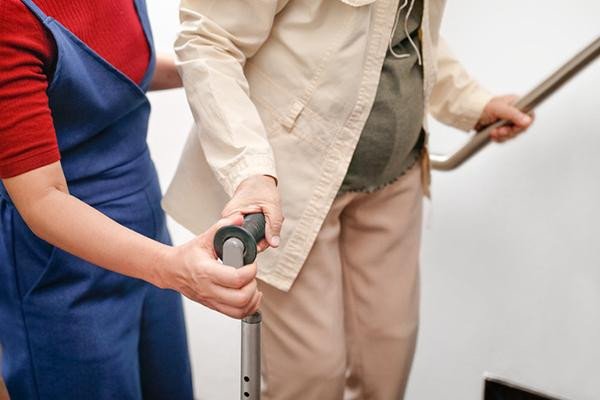Falls are a serious health concern for older adults, often leading to injuries that can significantly impact their quality of life. In fact, one in four older adults falls each year, with many falls resulting in broken bones, head injuries, or even long-term disabilities. However, the good news is that falls can often be prevented with the right strategies. By addressing multiple risk factors at once, older adults can improve their overall safety and reduce the likelihood of a fall.
1. Physical Activity: Strengthen and Balance
One of the most effective ways to reduce the risk of falls is through regular physical activity. Keeping the body strong and agile can help prevent trips and slips. Balance exercises, in particular, have shown to significantly lower the chances of falling.
- Focus on Balance and Strength: Activities such as Tai Chi, yoga, and simple stretching exercises help improve coordination and stability. Weight-bearing exercises, like walking or light strength training, enhance muscle strength, which is crucial for maintaining balance.
- Incorporate Functional Exercises: Functional exercises, such as standing up from a chair without using hands or walking heel-to-toe, mimic daily activities, which can improve overall mobility and prevent falls.
2. Home Modifications: Make the Environment Safer
Most falls occur in and around the home, where hazards can be easily overlooked. Simple changes to the home environment can greatly reduce fall risks.
- Clear Clutter and Obstacles: Keep walkways clear of obstacles like loose rugs, electrical cords, or furniture that may obstruct movement. Even small items can create tripping hazards.
- Install Grab Bars and Handrails: Installing grab bars in bathrooms, especially near toilets and showers, and handrails along stairways can provide support and prevent slips. In the bathroom, non-slip mats or adhesive strips in the bathtub or shower can offer additional traction.
- Ensure Proper Lighting: Good lighting is essential in preventing falls. Place nightlights in hallways and bathrooms to make nighttime trips safer. Well-lit stairways are especially important, as is ensuring that light switches are easy to reach.
- Consider Flooring Adjustments: If possible, opt for non-slip, smooth flooring in high-traffic areas. Avoid slippery tile or hardwood flooring, which can increase the risk of a fall when wet.
3. Regular Vision and Hearing Checkups
Impaired vision and hearing can significantly contribute to the risk of falling. Regular checkups can help identify and address issues before they become dangerous.
- Schedule Eye Exams: Vision problems, such as blurry vision, glaucoma, or cataracts, can affect depth perception and balance. Regular eye exams are crucial for older adults to detect these issues and receive corrective treatment.
- Corrective Lenses: Ensure that glasses prescriptions are up to date and that lenses are free from scratches or damage. For those with macular degeneration or other vision impairments, using magnifying aids or brighter lighting can also help.
- Address Hearing Loss: Hearing loss can make it difficult to respond to environmental cues, such as alarms or approaching footsteps. Hearing aids can help improve hearing ability, making it easier to navigate both at home and outdoors.
4. Medication Review: Minimize Risks
Certain medications can increase the risk of falls by affecting balance, coordination, and reaction times. A comprehensive review of medications is an essential part of fall prevention.
- Consult with a Healthcare Professional: Speak with a doctor or pharmacist about the potential side effects of medications, especially if they cause dizziness, drowsiness, or balance issues. Some medications, like sedatives, blood pressure pills, and antidepressants, can increase fall risks.
- Review All Medications: It’s important to review both prescription and over-the-counter medications regularly. The goal is to minimize the number of medications taken, especially those that may negatively affect mental clarity or stability.
- Take Medications as Prescribed: Ensure that medications are taken exactly as directed, avoiding missed doses or changes in dosage without consulting a doctor.
5. Proper Footwear: The Foundation of Stability
Footwear plays a pivotal role in maintaining balance and preventing falls. Ill-fitting shoes or slippers can increase the risk of tripping.
- Wear Supportive, Non-Slip Shoes: Choose shoes with a low heel, a wide toe box, and non-slip soles. This helps maintain balance and reduces the risk of slipping on smooth surfaces.
- Avoid Loose or Open-Toed Shoes: Slippers with no back straps or shoes that are too large can cause the foot to slip out, increasing the chance of tripping.
- Regular Foot Care: Regular foot checks for issues such as bunions, corns, or blisters can prevent foot problems from becoming an obstacle to safe mobility.
6. Encourage Social Engagement and Mental Health
Isolation and depression are common among older adults and can contribute to a lack of physical activity and poor decision-making, which can increase fall risks. Encouraging social interaction and mental wellness can have a profound impact on fall prevention.
- Stay Socially Active: Regular social interaction helps improve mood and motivation, reducing the likelihood of depression and anxiety that might contribute to a fall. Participating in group activities or simply visiting family and friends can make a difference.
- Mental Stimulation: Engage in activities that stimulate the mind, such as puzzles, reading, or learning new skills. Mental sharpness can play a key role in improving physical coordination and decision-making.
7. Proactive Health Management: Regular Checkups
Regular health checkups are an important preventive measure. Addressing underlying health conditions early on can greatly reduce fall risks.
- Manage Chronic Conditions: Conditions like diabetes, arthritis, and heart disease can affect strength, balance, and mobility. Working closely with a healthcare provider to manage these conditions will help reduce the risk of falls.
- Bone Health: Osteoporosis, a condition where bones become brittle and fragile, increases the risk of fractures from falls. Ensuring adequate calcium and vitamin D intake, along with weight-bearing exercises, can help maintain bone strength.
Conclusion
Falls in older adults are a significant health risk, but they are largely preventable with a multifaceted approach. By focusing on physical activity, home safety, regular health checkups, and mental well-being, older adults can greatly reduce the risk of falling. A combination of these strategies ensures that falls are less likely to occur, leading to healthier, safer living environments for seniors. Each step taken toward fall prevention contributes to greater confidence, independence, and quality of life for older adults.

